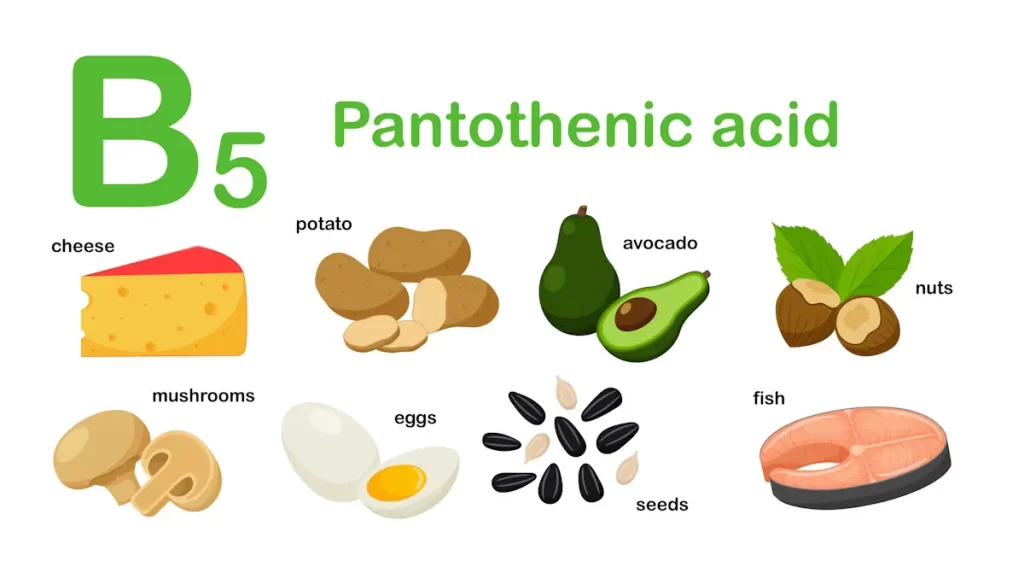Feeling tired or struggling with low energy can be frustrating. Vitamin B5, also called pantothenic acid, helps your body turn food into fuel and supports healthy skin, hair, and nerves.
Thank you for reading this post, don't forget to subscribe!This blog will explain its benefits, food sources, and why it matters for your health. Keep reading—you’ll learn something useful!
Key Takeaways
- Vitamin B5, also called pantothenic acid, helps turn food into energy and keeps skin, hair, and nerves healthy. It mainly works through Coenzyme A (CoA) in metabolism.
- Key sources include meat (like chicken liver), whole grains (brown rice), vegetables (broccoli, sweet potatoes), legumes (lentils), and dairy products like milk.
- Deficiency is rare but can cause fatigue, insomnia, stomach pain, or burning feet syndrome. High doses are generally safe due to its water-soluble nature.
- Pregnant women need 6 mg daily; lactating mothers require 7 mg to support their energy needs and infant health. Adults typically need 5 mg per day for good metabolic function.
- Pantothenic acid supports stress relief by aiding cortisol production in the adrenal glands. It also helps lower LDL cholesterol while increasing HDL levels—boosting heart health over time!
Key Functions of Vitamin B5 in the Body

Vitamin B5 plays a big role in keeping your body running smoothly. It helps break down food into energy and supports many key processes.
Role in Energy Production
Pantothenic acid helps your body turn food into energy. It converts carbohydrates into glucose, a key fuel for cells. This process happens through coenzyme A (CoA), which plays a central role in breaking down fats, proteins, and sugars.
CoA is crucial for the tricarboxylic acid cycle (TCA), also called the Krebs cycle. This cycle produces energy that powers every cell in your body. Without enough CoA, energy production slows—impacting physical and mental performance.
“Energy flows where nutrients go.”
Synthesis of Coenzyme A
Coenzyme A (CoA) is made through a five-step process. It starts with the phosphorylation of pantothenate, also called vitamin B5. This step uses the enzyme pantothenate kinase, which controls how much CoA is produced.
Feedback from CoA and its thioesters keeps this process balanced to avoid excess.
After the first step, molecules like cysteine and ATP join in to form the final CoA structure. Each step builds on the last until CoA is ready for use in metabolism. Without enough vitamin B5, this process slows down, impacting energy production and cell fat breakdown.
Metabolism of Fats, Proteins, and Carbohydrates
Vitamin B5 helps the body break down fats, proteins, and carbohydrates for energy. This process happens mainly through coenzyme A (CoA), which greatly converts food into fuel.
About 85% of dietary pantothenic acid is stored in the body as CoA or phosphopantetheine.
Fats are broken into fatty acids that CoA processes further—this supports energy production and cholesterol synthesis. Proteins become amino acids, while carbs turn into glucose for quick energy.
These metabolic functions keep your body running smoothly every day!
Health Benefits of Pantothenic Acid
Pantothenic acid helps your body heal faster and stay strong under stress. It also plays a key part in keeping your skin smooth and hair shiny.
Supports Adrenal Health
Vitamin B5 plays a big role in keeping adrenal glands healthy. It helps produce cortisol, a hormone needed for managing stress and reducing inflammation. Balanced cortisol levels can improve energy and mood.
Higher intake of pantothenic acid may boost adrenal function during times of stress or fatigue. This support aids the body’s response to physical and mental challenges. Healthy adrenals also help maintain better blood pressure and immune health over time.
Enhances Wound Healing
Strong adrenal health supports overall healing. Pantothenic acid helps repair tissues faster. This process is stronger with vitamin C. Studies on rabbits showed improved wound recovery using pantothenic acid supplements.
Pantothenic acid also boosts collagen production, important for skin repair. It reduces inflammation around wounds, promoting faster closure. Wounds may heal more effectively with a healthy diet rich in B vitamins and ascorbic acid.
Contributes to Reduced Cholesterol Levels
Pantothenic acid helps break down fats in the body. This process lowers LDL cholesterol, also known as “bad” cholesterol, while raising HDL or “good” cholesterol levels. Coenzyme A (CoA), made from Vitamin B5, plays a big role here by improving fat metabolism.
Studies show its effects can be significant. One research found that CoA supplements reduced triglycerides by 33%. They also cut down total cholesterol and improved heart health markers.
These benefits make pantothenic acid an important tool for managing high cholesterol and supporting healthy blood fats.
Crucial for Healthy Skin and Hair
Vitamin B5 helps keep skin soft and healthy. It boosts moisture levels, reducing dryness and irritation. Dexpanthenol, a form of this vitamin, is often used to treat atopic dermatitis.
This nutrient also supports the repair of damaged skin by aiding in wound healing.
Hair benefits greatly too. Vitamin B5 strengthens hair follicles and reduces breakage. It nourishes the scalp, promoting thicker and shinier strands over time. These effects make it key for maintaining vibrant skin and hair health daily.
Dietary Sources of Vitamin B5
Vitamin B5 is found in many common foods we eat daily. Adding these nutritious options to your diet can help maintain energy and support overall health.
Meat and Poultry
Organ meats, beef, and chicken are rich in pantothenic acid. Liver stands out with 8 mg of vitamin B5 per 100 grams. Chicken provides a decent amount too—1.2 mg per 100 grams. These foods make it easy to meet your daily dietary intake.
Adding these to meals supports energy production and metabolic processes. They also contribute to healthy eating by boosting skin health and adrenal function. Keep reading for other sources like grains and vegetables!
Whole Grains
Whole grains like brown rice, oats, and whole wheat bread are rich in vitamin B5. Fresh, unprocessed grains provide more pantothenic acid than refined options. Milling removes the outer layers of grains, where most nutrients are found.
This process significantly lowers their vitamin content.
Foods made from fortified cereals can also be a good source of pantothenic acid. Always check labels to ensure they include added vitamins. Incorporating these grains into your diet supports healthy eating and boosts B-complex vitamin intake.
Vegetables and Legumes
Broccoli, sweet potatoes, and corn naturally boost vitamin B5. These vegetables are easy to include in meals and support healthy eating habits. Broccoli can be steamed, roasted, or added to soups for variety.
Sweet potatoes work baked or mashed as a side dish packed with nutrients.
Lentils and soybeans stand out among legumes rich in pantothenic acid. Lentils fit well into soups or salads, while soybeans shine as tofu or edamame snacks. Both foods help meet dietary reference intakes for this water-soluble vitamin without extra effort.
Dairy Products
Milk, cheese, and yogurt are great sources of vitamin B5. Dairy products provide about 0.35 mg of pantothenic acid per 100 grams of milk. This makes them convenient options for boosting your daily intake.
Including dairy in your diet supports healthy skin, adrenal glands, and energy metabolism. For instance, a glass of milk with meals can add both nutrition and flavor to your day!

Vitamin B5 Deficiency and Toxicity
A lack or excess of Vitamin B5 can lead to health issues, making it vital to balance intake—read more about the signs and risks.
Signs and Symptoms of Deficiency
Lack of vitamin B5 is rare, but it can still happen. The body needs pantothenic acid for energy and proper function.
- Fatigue can occur because the body struggles to make energy from food.
- Insomnia is another common sign linked to low vitamin B5 levels.
- Depression or irritability may develop due to its role in brain chemicals.
- Vomiting and nausea may appear as digestive systems weaken.
- Stomach pain or cramps often happen with deficiency cases.
- Burning feet syndrome is a classic symptom, causing discomfort in nerves.
- Weak immune response makes infections like upper respiratory issues more likely.
- Muscle cramps might appear during physical activity due to low nutrient supply.
Make sure you eat enough foods rich in pantothenic acid to stay healthy!
Potential Effects of Toxicity
High intakes of vitamin B5 have shown no toxic effects. Even large doses, like 10 grams daily, usually only cause mild issues. Some people may experience stomach upset or diarrhea at these amounts.
Pantothenic acid is water-soluble. This means extra amounts leave the body through urine, reducing risks of buildup. It’s safe for most people even in high dietary intake levels.
Risk Groups for Deficiency
Some people are at a higher risk of vitamin B5 deficiency. This can happen due to poor nutrition or certain health conditions.
- People with severe malnutrition
Those who cannot meet their basic dietary needs may lack vitamin B5. Limited access to food or eating disorders often lead to deficiencies. - Individuals with genetic disorders
Conditions like pantothenate kinase-associated neurodegeneration (PKAN) make it hard for the body to use this vitamin properly. PKAN is rare but serious, leading to neurological issues. - Alcoholics
Regular alcohol consumption reduces nutrient absorption in the gut. This can deplete essential water-soluble vitamins like pantothenic acid over time. - Pregnant women
During pregnancy, the demand for vitamins increases significantly, including B5. Without proper dietary intake, they may experience shortages. - Older adults
Aging often lowers appetite and nutrient absorption capacity, putting older individuals at risk of deficiency. - People on restrictive diets
Vegans or those avoiding animal products might miss out on sources rich in vitamin B5, such as meat and dairy. - Patients with gastrointestinal diseases
Diseases like Crohn’s or celiac disease impair nutrient absorption in the intestines, increasing deficiency risks. - Breastfeeding mothers
Lactation demands more nutrients to produce sufficient human milk, making adequate dietary intake crucial. - Individuals taking specific medications
Certain drugs can interfere with nutrient breakdown and absorption, increasing the likelihood of shortage over time. - Athletes under extreme stress
Intense physical exertion leads the body to burn through resources faster, including vitamins critical for metabolism and energy production like pantothenic acid (B5).
Recommended Daily Intakes
The amount of vitamin B5 you need changes with age and life stages. Knowing the right intake can help keep your body running smoothly—read on to learn more!
For Infants and Children
Infants need 1.7 mg of vitamin B5 daily from birth to six months. Breast milk or formula usually meets this requirement. It helps their bodies make energy and supports healthy growth.
Children’s needs vary by age. Kids aged 1–3 require 2 mg daily, while those between 4–8 need 3 mg per day. A child’s diet should include foods like whole grains, eggs, or dairy products for adequate intake…
Next up: adults and elderly!
For Adults and Elderly
Adults need 5 mg of pantothenic acid daily. This helps maintain energy levels and supports healthy metabolism. It also keeps skin, hair, and adrenal glands functioning well. Foods like whole grains, egg yolks, and dairy are great sources to meet this requirement.
For the elderly, pantothenic acid remains vital for maintaining overall health. While there’s no upper intake level set, consuming a balanced diet with meats or legumes can prevent any risk of deficiency.
A diet rich in B-complex vitamins promotes energy production and may reduce fatigue as people age.

During Pregnancy and Lactation
Pregnant women need 6 mg of pantothenic acid daily. This vitamin supports the baby’s nervous system’s development and helps metabolize macronutrients like fats, proteins, and carbohydrates.
It also plays a role in reducing stress by supporting adrenal gland function.
Lactating women require slightly more—7 mg per day—to meet their own needs and support milk production. Vitamin B5 aids energy production for both mother and child during this period.
Dietary sources like whole grains, dairy products, meat, and vegetables can help maintain healthy levels.
Vitamin B5 in Metabolic Processes
Vitamin B5 helps the body use fats, proteins, and carbs for energy. It also supports key chemical reactions that keep cells working well.
Involvement in the Krebs Cycle
Coenzyme A (CoA), made from pantothenic acid, drives the Krebs cycle. This cycle produces energy for your body by breaking down fats, proteins, and carbohydrates. It happens in cells’ mitochondria—your body’s energy powerhouses.
Acetyl-CoA starts many reactions in the Krebs cycle. These reactions produce ATP—the main energy currency of your body. Without CoA from vitamin B5, this vital process would not run smoothly.
Importance in Fatty Acid Synthesis
Pantothenic acid helps make Coenzyme A (CoA) and acyl carrier protein. These molecules play key roles in fatty acid metabolism. CoA activates fatty acids, preparing them for energy use or storage.
The acyl carrier protein assists in building new fatty acids, which are crucial for cell membranes and hormones.
Without enough vitamin B5, the body struggles to break down fatty acids or create new ones. This can impact cholesterol levels and overall health. Pantothenic acid also supports enzymes needed during these processes, making it vital for proper fat metabolism.
Role in Hormone and Neurotransmitter Production
Acetyl-CoA, created from pantothenic acid, helps produce acetylcholine. This neurotransmitter supports memory and muscle function. Coenzyme A (CoA) also aids in making stress hormones like cortisol in the adrenal glands.
These processes rely on vitamin B5 to run smoothly.
CoA works with enzymes involved in hormone synthesis. It plays a role in producing melatonin for sleep and serotonin, which affects mood. Without enough vitamin B5, these vital functions may slow down—leading to health issues such as stress or fatigue.
Next: Clinical Applications and Therapeutic Uses…
Clinical Applications and Therapeutic Uses
Vitamin B5 aids stress relief, balances cholesterol, and supports joint health—learn how it can improve your well-being.
Management of Stress and Anxiety
Pantothenic acid is often called the “anti-stress” vitamin. It helps produce stress-related hormones in the adrenal glands. These hormones, like cortisol, play a key role in managing your body’s response to stress and anxiety.
Balanced levels of these hormones can keep you calm during tense situations.
Low pantothenic acid levels may lead to fatigue or worsening anxiety symptoms. Foods like whole grains, organ meats, eggs, and sunflower seeds are rich sources of this nutrient. Including them in your diet supports overall mental health and energy production.
Role in Managing Dyslipidemia
Stress can impact cholesterol levels, but vitamin B5 helps balance them. It promotes the breakdown of fats, supports HDL cholesterol and reduces LDL cholesterol. A study showed CoA supplements cut triglycerides by 33%, which may lower heart disease risks.
Pantothenic acid aids in cholesterol synthesis regulation. This process keeps your body from producing too much bad cholesterol. By improving fat metabolism, it supports healthier lipid profiles over time.
Potential Benefits in Rheumatoid Arthritis
Pantothenic acid may help ease rheumatoid arthritis (RA) symptoms. Early studies suggest lower vitamin B5 levels in people with more severe RA cases. This could mean a link between pantothenic acid deficiency and increased inflammation or joint pain.
Some reports show potential relief from morning stiffness and reduced swelling when patients maintain healthy dietary intake of this nutrient. While further research is needed, foods rich in vitamin B5—like whole grains, egg yolks, and organ meats—may support better joint health over time.
Conclusion
Vitamin B5 plays a big role in keeping your body healthy. It helps produce energy, supports your skin and hair, and even aids cholesterol management. You can find it in many foods like meat, grains, and veggies.
While deficiency is rare, balanced intake is key for good health. Consider adding B5-rich foods to your meals!
